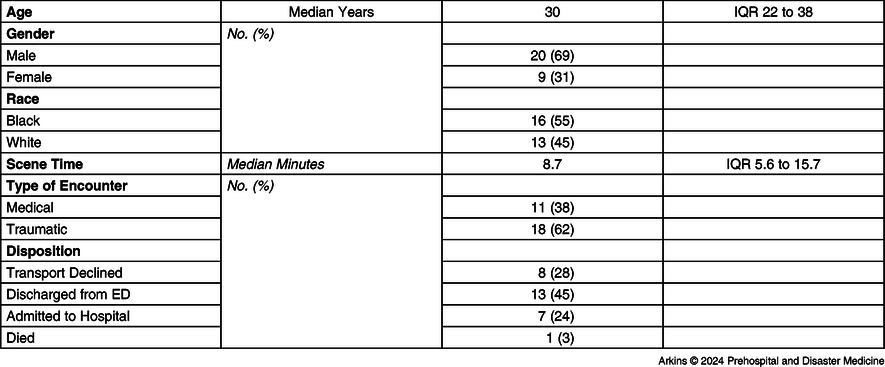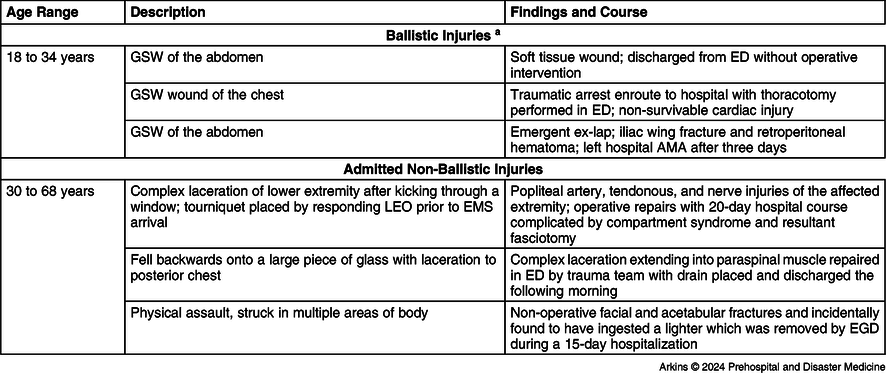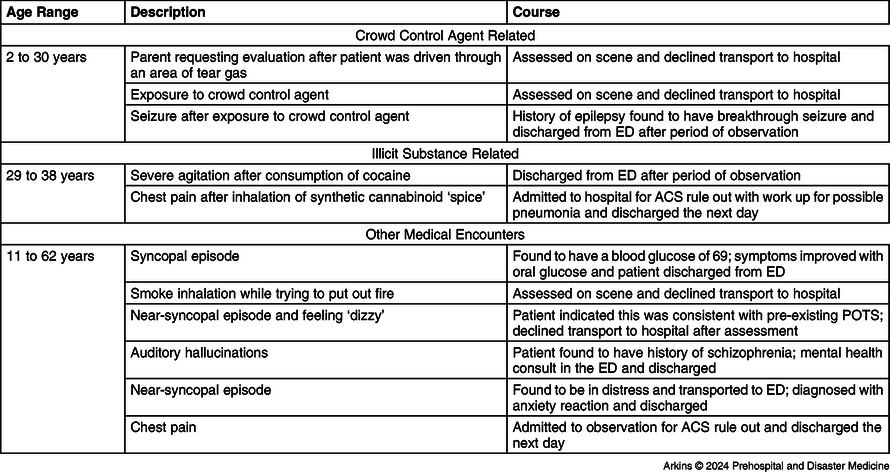Introduction
Beginning in late Spring 2020, protests and civil unrest erupted across many cities throughout the United States following the death of George Floyd in police custody. Reference Taylor1 At the height of the civil unrest, Indianapolis, Indiana experienced four nights of violence and property destruction requiring a specialized public safety response.
When peaceful protests devolve into civil unrest, local health care resources such as emergency departments (EDs) and trauma centers may be stressed due to the increased risk of injuries to civilians as well as public safety personnel. In addition to violence perpetrated by civilians, crowd displacement efforts by law enforcement in response to civil unrest can also present safety risks. Both chemical agents, such as tear gas, and impact munitions may be utilized for crowd displacement. Previous studies have described injuries, including permanent disability and death, from these methods. Reference Suyama, Panagos, Sztajnkrycer, FitzGerald and Barnes2,Reference Haar, Iacopino, Ranadive, Dandu and Death3 Emergency Medical Services (EMS) personnel are often the first clinicians to evaluate injuries sustained during civil unrest. At the time of this writing, there are no previous comprehensive descriptions of injuries and medical illnesses encountered by EMS personnel during these events.
Understanding the associated injury and illness patterns encountered in civil unrest can help public safety and health care teams develop appropriate training and planning to improve future responses to similar events. Additionally, such understanding provides insight into implications of potential operational stress on an EMS system caring for patients in a civil unrest event. In this study, the local EMS response and the patient encounters are described that directly corresponded to the civil unrest over a four-day period in Spring 2020 in a large Midwestern city in order to better understand the medical and public safety demands related to such events.
Methods
In this retrospective case series study, patients encountered by EMS within the area of the civil unrest occurring in Indianapolis, Indiana on the evenings starting May 29 through June 1, 2020 were included. The area of civil unrest was defined by the Indianapolis Metropolitan Police Department. This area covered 15 blocks by 12 blocks (roughly 4.0 square miles) and included central downtown Indianapolis.
Each operational period was assigned a unique public safety incident number specific to the date and event such that related EMS activations could be queried directly by their affiliation with the event through the EMS electronic medical record (EMR). All EMS requests in the zone of civil unrest were routed to the unified command structure established by police, fire, and EMS for resource deployment as needed.
Forty EMS incidents in the computer automated dispatch system met inclusion criteria based on being affiliated with the unique incident numbers associated with the civil unrest. Of those incidents, 11 records were dropped for the following reasons: no patient was found at the scene, the incident was a duplicate of another pre-existing record, the EMS unit was dispatched to an area on standby where there was no patient contact, or the EMS unit was disregarded enroute to the patient by the unified command.
All of the remaining patient encounters were included in the study with the EMS and hospital records reviewed by two individuals with no adjudications required. The data management team collected demographics, scene times, interventions, dispositions, EMS clinician narratives, transport destinations, and hospital course with outcomes from receiving hospitals where applicable. The analysis was descriptive in nature and reviewed all patient encounters with no comparisons between groups.
The second night of unrest saw the implementation of three extraction ambulances in the protest area. Extraction ambulances were staffed with an EMS physician, two tactical paramedics, and two law enforcement officers (LEOs), all of whom wore ballistic personal protective equipment (PPE) and had respiratory protection rated for crowd control agents. The sole purpose of the LEOs on the ambulance was to provide protection for the EMS crew. These officers were not part of any civil control efforts, nor did they attempt to make any arrests. The goal of the extraction ambulance was to rapidly evacuate patients in areas of unrest and either transfer the patient at an ambulance exchange point in a safer location to another EMS crew, or if clinically indicated, transport directly to a trauma center.
Each day of unrest was defined as starting in the evening of one date while the unified command structure was in place until it was subsequently disbanded by the incident commander. This corresponded to 8:56pm May 29 to 4:38am May 30, 4:14pm May 30 to 3:57am May 31, and 5:59pm May 31 to 11:21pm on May 31. There was only one patient on June 1 as the downtown area was largely empty following a police-enforced curfew. According to an independent review of the public safety response during the civil unrest, the crowds numbered in at least the “hundreds” at times, however no official estimate was given. Reference Sheridan4
Scene time was defined as the duration of time from when the extraction team was marked on scene locating the patient to the time when the team was marked leaving the scene with or without the patient. Race data were extracted from the EMS EMR. While the ages of patients were known, age ranges were reported instead in order to protect patient privacy.
Age is described using median and interquartile range (IQR). Demographics, injury mechanism, and dispositions are described using frequencies and percentages.
The institutional review board at Indiana University (Indianapolis, Indiana USA) reviewed, approved, and granted exempt status to this project (protocol number 2010433487).
Results
Twenty-nine patients were encountered by EMS during the four nights of civil unrest. Volume of EMS in the affected area doubled from eight on the first night to sixteen on the second night, which coincided with the largest incidence of violence and property destruction. A city-wide curfew was imposed from 8:00pm on May 31 to 6:00am on June 1. There were only five total EMS encounters on the two days following the institution of the curfew.
Patients’ ages ranged from two to sixty-eight years. Forty-five percent of patients treated were identified as white. Overall, EMS transported twenty-one patients to one of three receiving hospitals, and eight patients declined transport. Among patients transported, seven patients were admitted to the hospital and there was one fatality after transport (Table 1).
Table 1. Patient Encounter Characteristics

Abbreviation: ED, emergency department.
Gunshot wounds (GSWs) accounted for ten percent (three of 29) of EMS activations (Table 2) but were involved in at least two additional fatalities over the four days within and during the civil unrest (data not shown). These two additional fatalities did not have EMS records due to a declaration of death prior to EMS extraction team activation or prior to EMS patient contact.
Table 2. Description of Traumatic Mechanisms of Injury and Outcomes

Abbreviations: GSW, gunshot wound; ED, emergency department; ex-lap, exploratory laparotomy; AMA, against medical advice; LEO, law enforcement officer; EMS, Emergency Medical Services; EGD, esophagogastroduodenoscopy.
a Two additional fatalities were not included in this data set. The patients were not treated or transported due to non-survivable trauma ballistic injuries.
Two patients in the study were LEOs evaluated after being struck with a brick and glass bottle, respectively. Both declined transport to the hospital. Six civilian patient encounters included references to law enforcement activities with four of those involving exposures to crowd control agents.
Eleven patients (38% of all patients) were assessed for non-traumatic illness (Table 3). This included three patients with complaints related to tear gas exposure and two patients with complaints related to illicit substance use. Three patients suffered syncopal or near-syncopal events. Of the eleven patients with non-traumatic complaints, two were admitted, both for chest pain with concerns for acute coronary syndrome (ACS).
Table 3. Non-Injury-Related Patient Encounters

Abbreviations: ED, emergency department; ACS, acute coronary syndrome; POTS, postural orthostatic tachycardia syndrome.
One extraction ambulance was damaged when a brick was thrown into its windshield. No EMS clinicians were injured during any of the incident days.
Discussion
Any large gathering, whether scheduled or spontaneous, requires a certain level of preparedness from public safety professionals and hospitals. While civil unrest events are not new to public safety, the growing number of events since the onset of the coronavirus disease 2019/COVID-19 pandemic created opportunities for public safety and medical directors to learn from and to prepare for future events. Reference Barrett5 Civil unrest can lead to a significant impact on public safety and hospitals if appropriate planning and mitigation strategies are not developed. In an environment where both entities are strained, an episode of violence and civil unrest can quickly overwhelm what limited resources exist.
Current United States guidelines for tactical EMS response have focused primarily on active assailants, such as an individual attempting a mass stabbing or shooting, including position statements from the Hartford Consensus and NFPA [National Fire Protection Association] 3000. However, specific national guidelines and recommended procedures are lacking for the EMS response to civil disturbances. A lessons-learned document from the United States Department of Health and Human Services (Washington, DC USA) encourages pre-planning, employee safety, intelligence gathering, and communications when responding to civil disturbances, but it does not address how best to rescue those who need care during a civil disturbance or clinical care modifications that may be necessary when doing so. 6
Response to civil unrest requires a careful consideration of PPE. For this incident, tactical EMS providers considered the ballistic threat and exposure to riot control agents to be of greatest concern due to reported gunfire, subsequent firearm injuries, and tear gas deployment. As such, they were equipped with ballistic helmets, vests, eye protection, and negative pressure full-face respirators. As the incident evolved, additional intelligence about the possibility of Molotov cocktails and other incendiary devices was obtained. In response, burn blankets and fire extinguishers were added to the equipment on the rescue ambulances. Had the risk of thrown projectiles or incendiary risks been higher, the PPE likely should have been modified to ensure that flame retardant clothing was worn, along with fire retardant gloves, limb protectors, and possibly helmet visors. It is the authors’ opinion that care must also be taken to distinguish EMS clinicians from LEOs, which can be accomplished with brightly colored American National Standards Institute (Washington, DC USA) vests.
In an independent review of the events during and after the incident, specific tactics by those who engaged in violence could not be readily identified. Protest organizers were recognized for attempting to dissuade acts of violence; as such, subsequent violent acts appeared to be uncoordinated, thereby preventing EMS from anticipating how the nights would unfold. These findings highlight the importance of flexible EMS planning in dealing with a civil disturbance event.
For this event, the use of chemical riot control agents involved 2-chlorobenzylidene malononitrile/CS gas, oleoresin capsicum spray, and the use of nonivamide powder dispersing projectiles (“Pepperballs”). The only requirement for decontamination for these agents was exposure to fresh air and potentially water, both of which were readily available to EMS. No patients required extensive decontamination. In anticipation of or in response to a potential chemical, biological, radiological, or nuclear event, the authors agree that public safety officials should have a mechanism by which to alert nearby hospitals to be ready for a large decontamination of victims outside of the hospital in order to prevent internal contamination of medical facilities.
In this study, the demographics, injury patterns, EMS call types, and outcomes that occurred during a period of recent civil unrest in a large urban environment are described. While most EMS transports did not result in hospitalization, it is important to note that the majority of EMS calls did result in a transport. This is important from a planning perspective in recognizing that EMS utilization will often lead to patient transport and subsequent increase in EMS turnaround time. Given these data, it is imperative that any medical response plan should include a backfill of transport ambulances in support of the event. Further, planning for safe and efficient patient extraction from areas of active unrest is crucial.
In this event, there were various examples of traumatic injuries, both blunt and penetrating, resulting from simple assault, ballistic injuries, and accidental self-inflicted injuries. The data also demonstrate that it is important to plan for a significant percentage of medical calls. Many of the calls were due to irritant gas exposure from crowd dispersion agents, and it is important to incorporate this factor into pre-event planning. Anecdotally, the presence of an EMS physician on an extraction ambulance was helpful to triage these medical cases. First responders, such as LEOs, who have received primarily trauma training, such as tourniquet use and hemorrhage control, may find themselves unprepared to render aid for medical patients.
Finally, the findings demonstrate a generally high level of acuity in the trauma patients encountered. This emphasizes the importance of ensuring that EMS clinicians minimize trauma scene times and provide rapid care in a safe manner. Due to the time critical nature of these injuries, Reference Moriwaki, Sugiyama, Toyoda, Kosuge, Tahara and Suzuki7–Reference Ohlén, Hedberg, Martinsson, von Oelreich, Djärv and Jonsson Fagerlund10 it is imperative that a response plan include a way to ensure scene safety for EMS clinicians in order to mitigate delays. In the system studied, this was accomplished by having law enforcement deployed on the extraction ambulances to provide immediate security for EMS clinicians. Additionally, the high acuity of trauma patients observed reinforces the need for close communication with regional trauma centers to ensure maximal preparedness for a surge of high acuity trauma patients.
Limitations
Limitations of this study included the fact that patients who may have presented to local hospitals via other means would not be captured in this data set. Additionally, given that the event happened in the downtown core of the city, some patients included may have required medical assistance unrelated to the civil unrest itself due to the high population density of the area and its known population of individuals experiencing homelessness who shelter within it.
Conclusions
This study describes a specialized EMS extraction unit that was deployed during four days of civil unrest in the core of a large city in the United States and the patients encountered by this unit. The findings highlight that traumatic injuries may be relatively severe during periods of unrest and that medical illnesses and needs are also common. The model for extraction units deployed was seemingly effective and can be replicated in similar scenarios.
Conflicts of interest
The authors report they have no conflicts of interest to declare.






